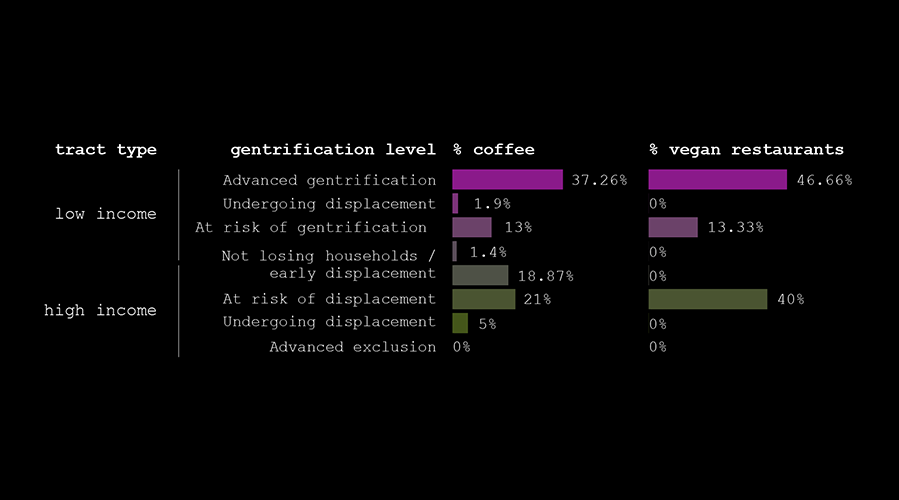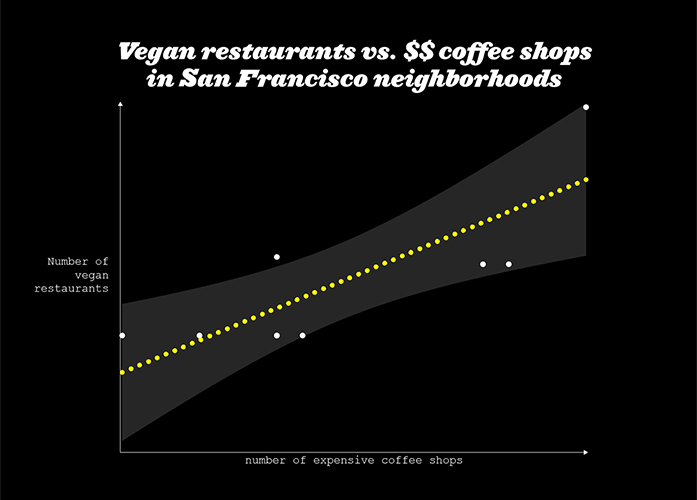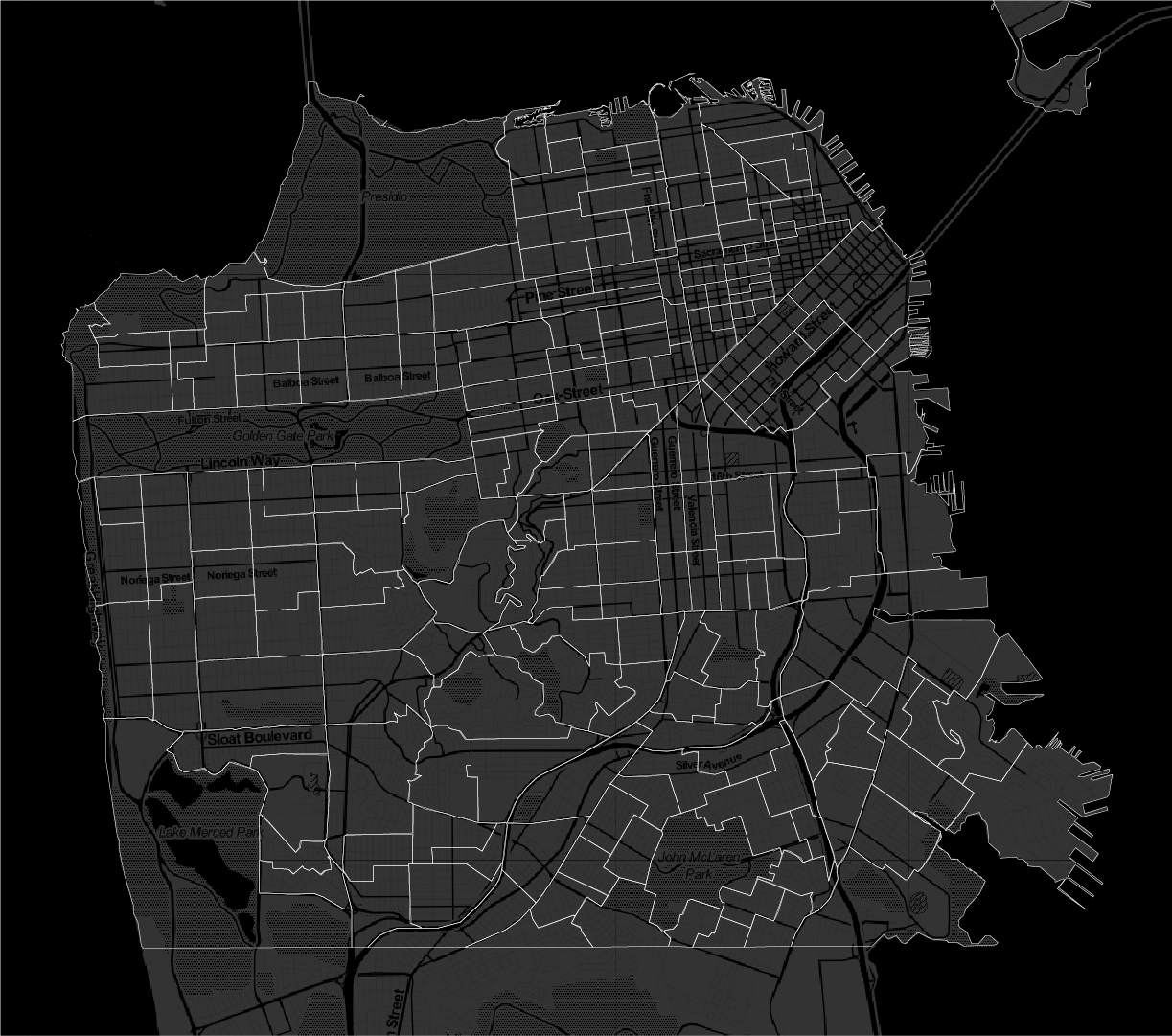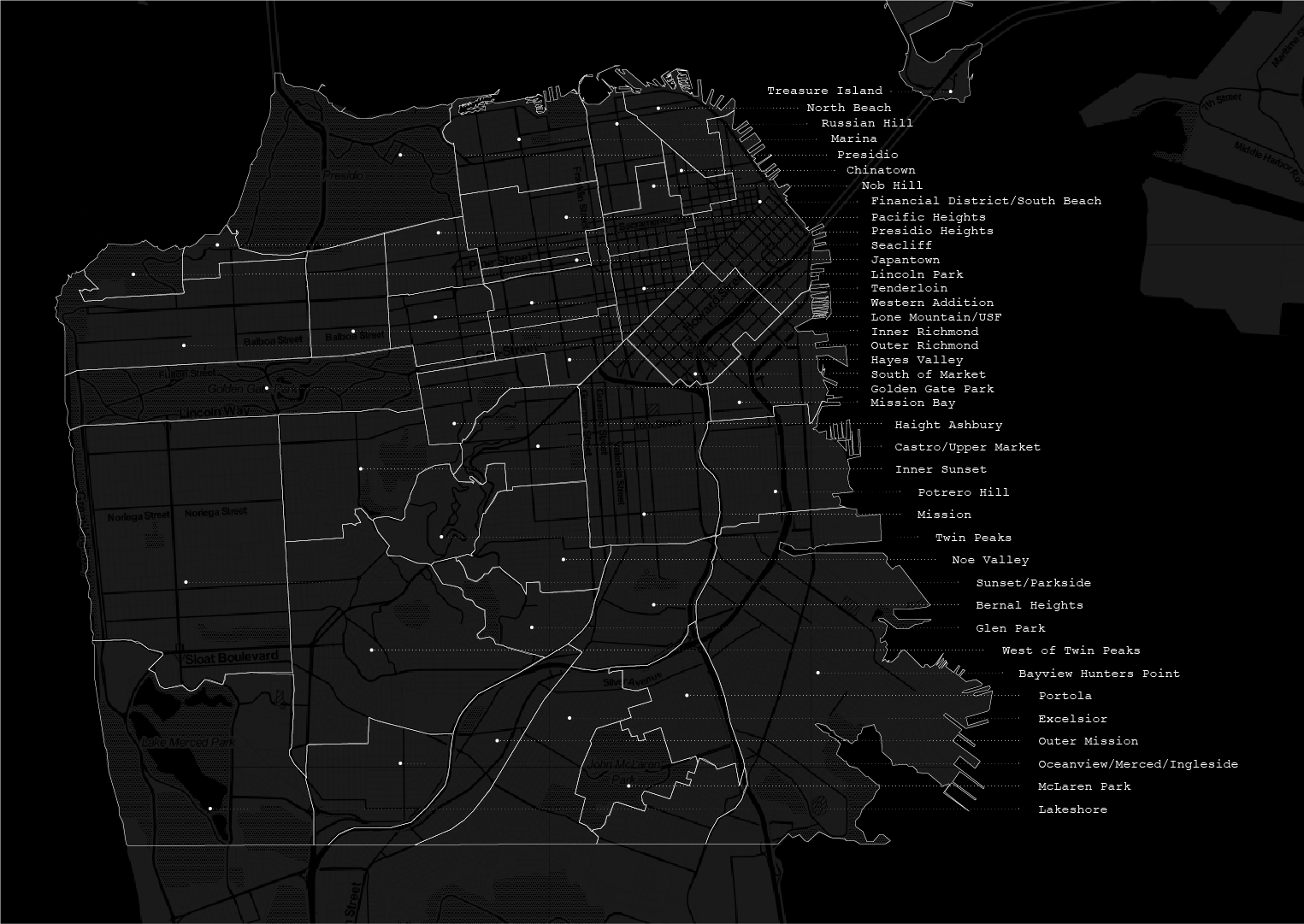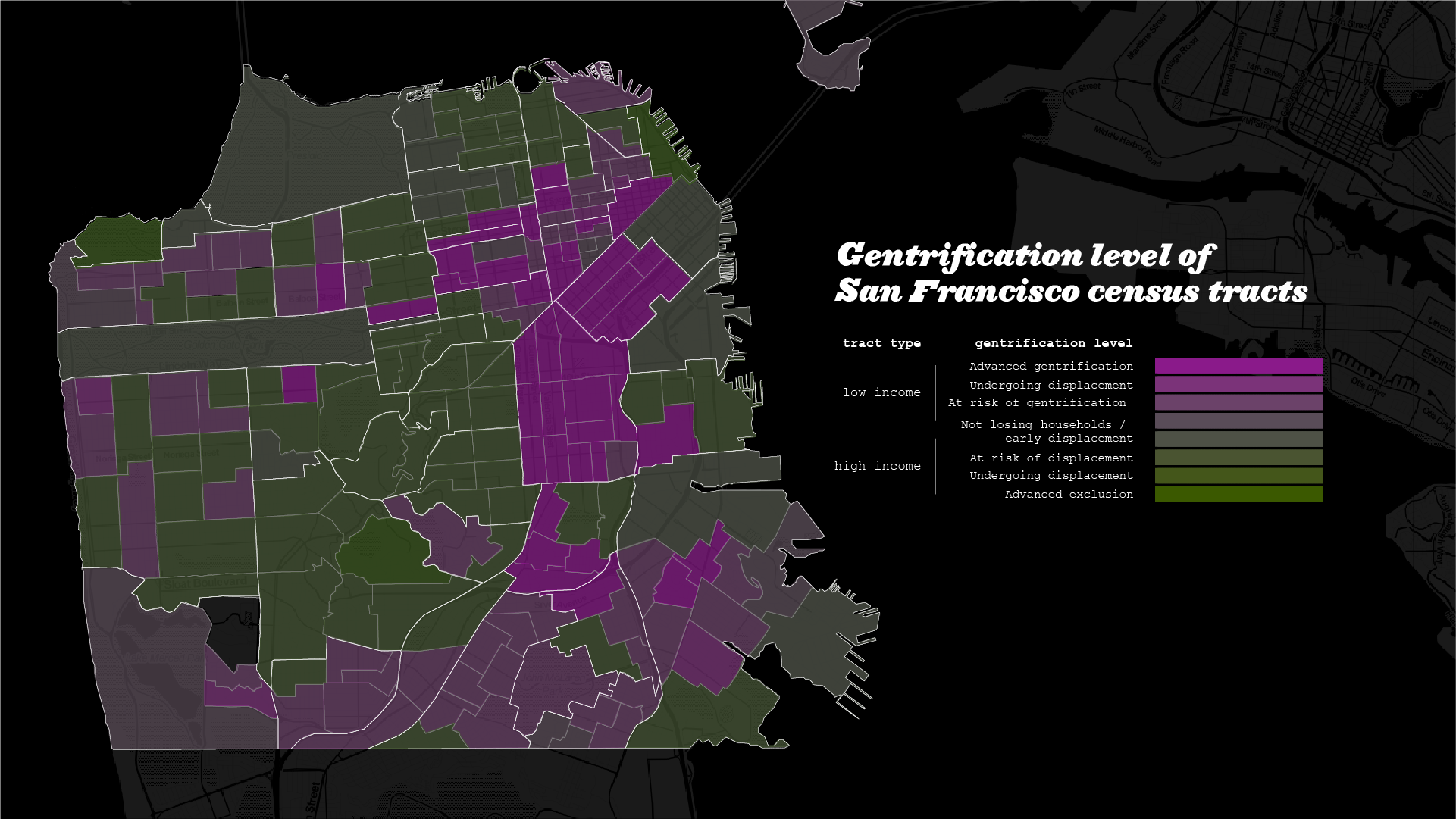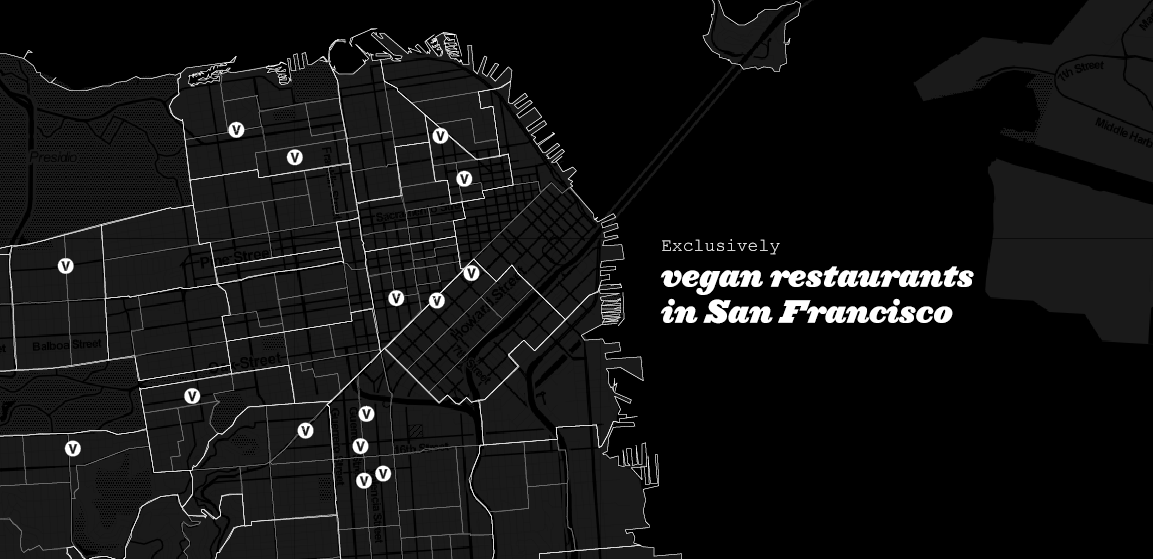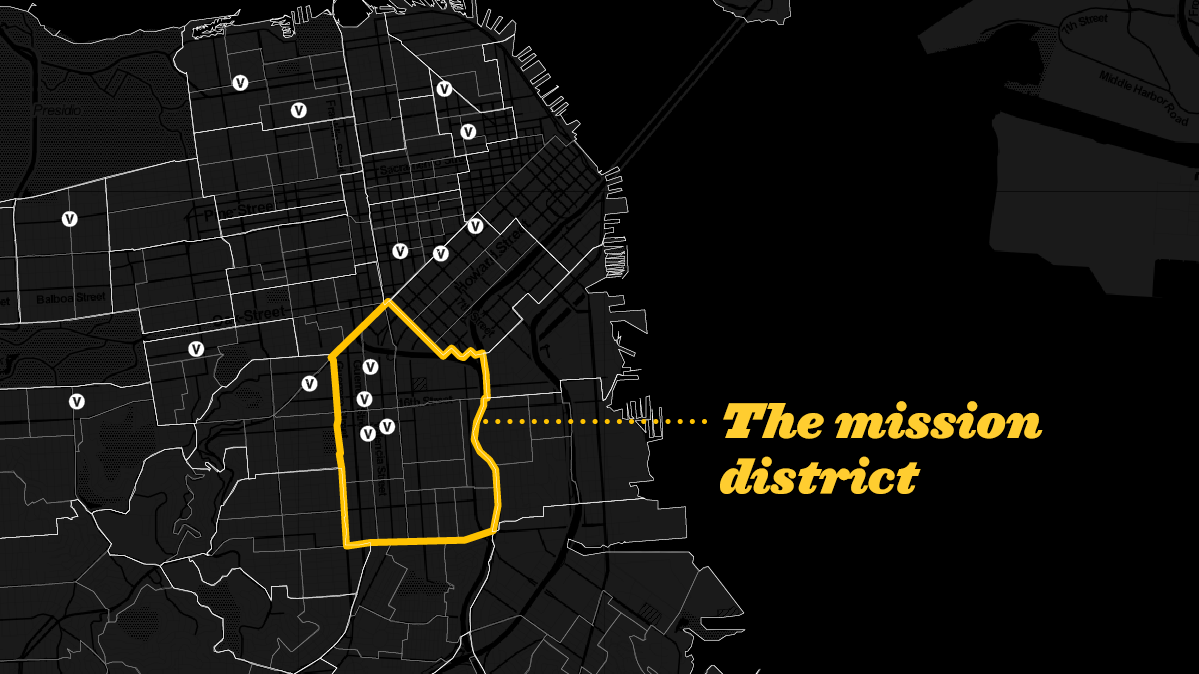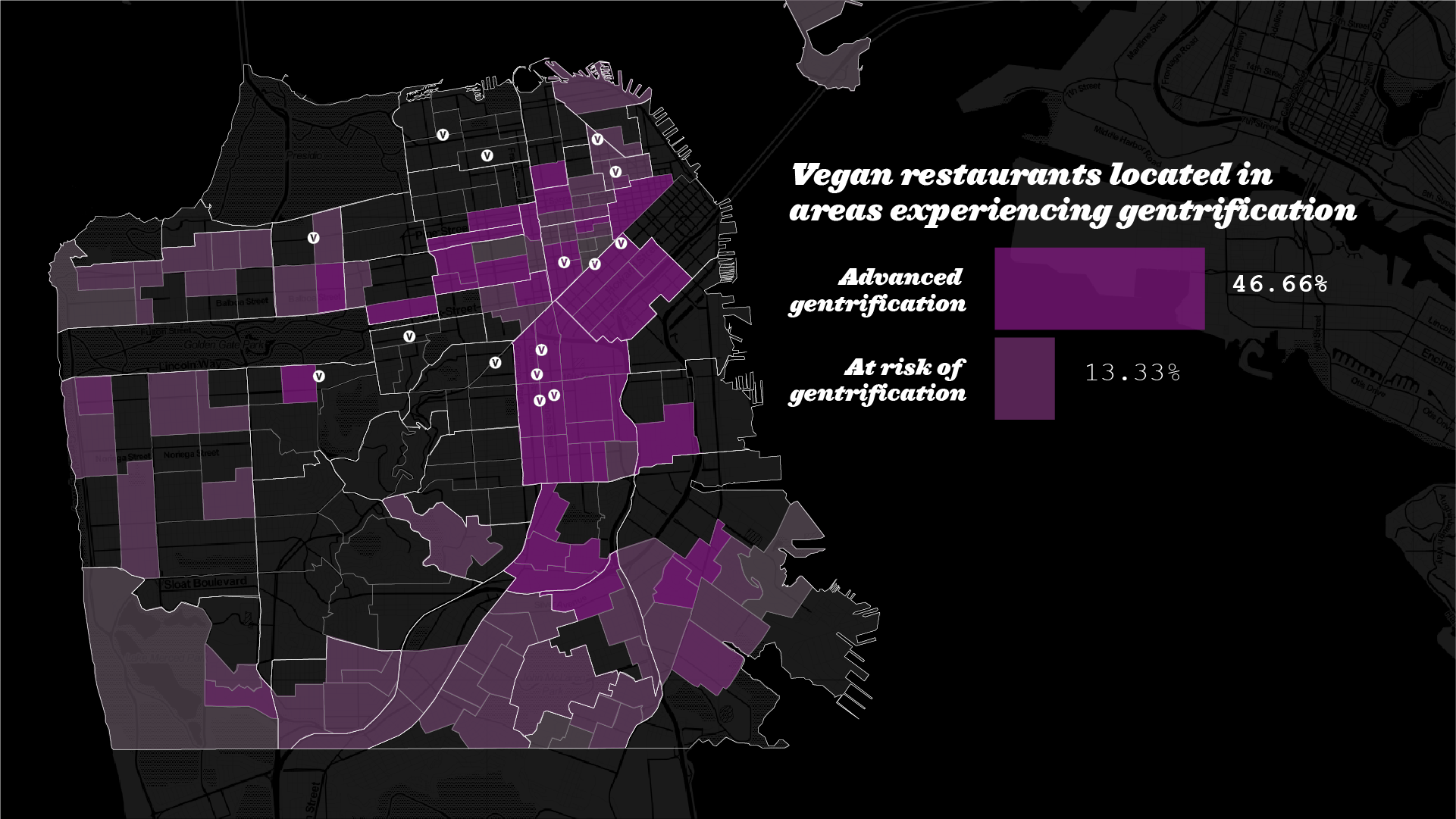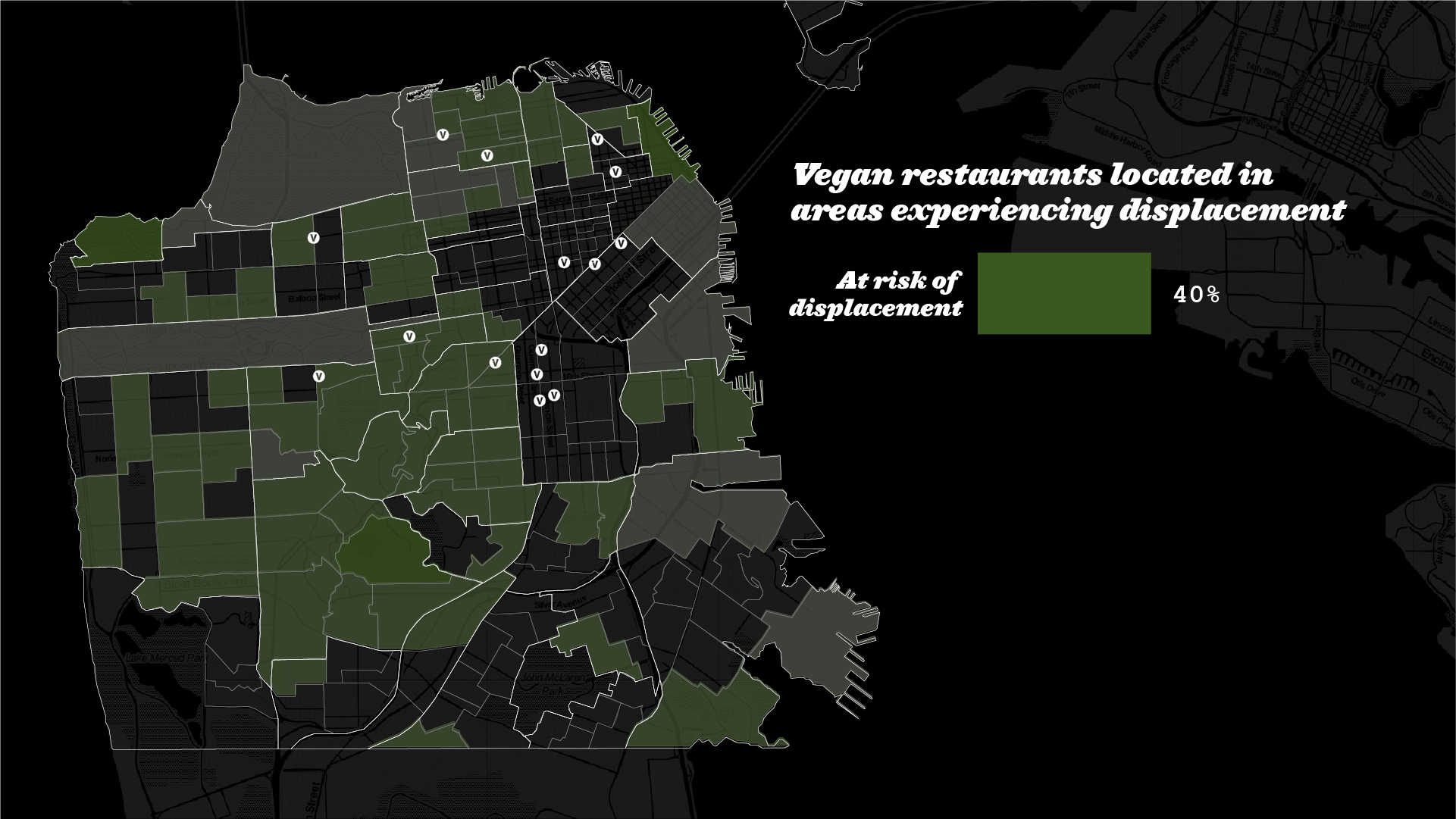A data-driven exploration of vegan restaurants as cultural indicators of gentrification. Geographically, vegan restaurants are disproportionately distributed in gentrified neighborhoods. Vegan restaurants are also distributed in gentrified neighborhoods in a similar way as coffee shops. Like coffee shops, vegan restaurants could be a cultural symbol of gentrification.
An overview of the project:
Background
On a seemingly inconsequential day, I checked out the art gallery next to one of my favorite coffee places. One piece, among several other painted skateboards, said: “Gentrification is modern-day colonialism”
I only had a fuzzy idea of what gentrification is, and its comparison to colonialism came out of left field. What did gentrification mean?
What is gentrification?
Sociologist Ruth Glass coined the term in 1964, defining it as a process by which “original working-class occupiers are displaced by an influx of higher-income newcomers” [1]
Stacey Sutton at a TEDxNewYork talk defines it a “processes by which higher income or higher status people relocate to or invest in low income neighborhoods. These neighborhoods have been historically dis-invested in. When people invest in these areas, it’s typically to capitalize on the low property values.” [18]
The day I saw the skateboard jolted me into an awareness of the process in which I was complicit.
I’ve realized “up-and-coming” is a way of describing how low income neighborhoods are changing rapidly due to the interests and movements of wealthier people.
The destructive nature of gentrification
Kai, a musician, describes in a piece by Buzzfeed the changes that have occurred in his childhood neighborhood, the mission district [42].
A prevailing narrative when people talk about gentrified neighborhoods is one of inflating property values, a severe change in the culture and character, and displacement. [5]
Displacement and gentrification are not synonymous, but they often occur at the same time [4].
Displacement describes how residents are forced to move out due to housing or neighborhood conditions. It occurs either when building conditions deteriorate, or when the costs of living rise. [4]
How to Measure Gentrification
There is a continual effort in academia and government to quantify, to measure when gentrification and displacement is actually occurring. This research has the potential for being used to inform new city planning policy, to prevent the mistakes of the past.
One such project in the Bay Area is the Urban Displacement project. It was formed with the concern of how development related to new transit investment would impact low income communities and communities of color.[20]
Researchers for the Urban Displacement Project developed a scheme for categorizing whether an area has been gentrified or is in the process of being gentrified. [20]
These researchers used this scheme to categorize the neighborhoods in several major metropolitan areas as experiencing gentrification, displacement, or both.
This is San Francisco, which has been demarcated into regions called census tracts by the government, which we can aggregate into more demographically and culturally cohesive “neighborhoods.”:
- Census tracts in San Francisco
- Neighborhoods in San Francisco
These are the regions in SF that are experiencing gentrification or displacement:
Gentrified regions are indicated by the increase in wealth in an area, number of residents holding college degrees, and the loss of low-income households. High income regions are indicated by experiencing displacement of low income households, due to loss of naturally affordable housing, and/or relative low in-migration of low income households.
I noticed a pattern here – the areas that were experiencing advanced gentrification were definitely considered the “cool” areas to hang out – at least to my friends.
Vegan Restaurants as Linked to Gentrification
When I’m travelling to different major cities across the country, I’ve noticed another pattern. Whether it be New York, Philadelphia, Dallas, or San Francisco, vegan restaurants tend to be clustered in “cool” neighborhoods.
My friends and I would talk about visiting cities based on the density of high quality vegan restaurants – their “vegan scene”
But there is an understanding that vegan restaurants are often part of the backdrop of a “hipster”, or gentrifying, neighborhood.
Former barista Molly Osberg notes this connection in the Brooklyn neighborhood surrounding her coffee shop:
“To staff a demographic shift as massive as the one that’s taken place around Williamsburg and Greenpoint requires quite a bit of manpower…We have rockabilly vegan diners … and the coffee shop where Hannah worked in ‘Girls.’”
Either way, When I visited San Francisco last spring, my knee-jerk reaction was to do what my friends recommended me to do – fully enjoy San Francisco’s “vegan scene”:
As I searched for a good vegan restaurant to check out in downtown San Francisco, I noticed something weird. Lots of the vegan restaurants tend to cluster in notoriously “gentrified” regions of SF.
For example, here is the mission district, an area that has often been at the center of the conversation about gentrification over the last several years:
The Mission is the neighborhood with the most vegan restaurants. I also find it interesting that the controversial Gracias Madre is located here – founded by the same couple that owns Cafe Gratitude and the controversial Be Love farm.
I wondered whether the implicit connection between vegan restaurants and gentrification could be validated with data.
Using the Urban Displacement Project’s classification of census tracts as gentrified, I found the the answer.
In fact, most vegan restaurants in San Francisco are in census tracts that are experiencing “advanced gentrification”:
The rest of the vegan restaurants in San Francisco that aren’t in gentrifying areas are in high income regions are at risk of losing affordable housing, in turn excluding low income families:
The data is pretty clear. There is indeed a strong relationship between the location of a vegan restaurant and whether that region is gentrified.
However, these metrics have limitations.
Although the categories of gentrification developed by the Urban Displacement project might useful to policy makers, these categories don’t capture how gentrification feels; what it means for the people who are affected by the often traumatic changes to the places they call home.
Furthermore, metrics don’t capture how vegan restaurants contribute to a changing cultural climate of a gentrifying neighborhood. They won’t illuminate whether vegan restaurants are indicative of the kind of cultural change associated with gentrification.
Coffee as a cultural indicator of gentrification
D.C. poet Zein El-Amine, in his piece Herring Highway, is reminded of “The Nothing” in the Neverending Story when he talks about gentrification [41]:
If you could
only see what has become of your city, the nothingness
spreading through it. The nothingness that straightens out all the curves,
rusts all that is rustic, dulls all texture, sanitizes all that is pungent.
We see it everywhere, as we expected it everywhere,
in the streets of my birth, in the streets of your birth,
in our exile, and in the exile from our exile.
This destruction, or re-imagining of culture is an important component of gentrification, signified by what cultural establishments are opened by gentrifiers. We can track gentrification in real time by looking at what types of establishments open in which neighborhoods [14].
This is because certain types of amenities and stores, as Molls Osberg writes, “arise to meet the demands of the shifting population,” the demands of the gentrifiers. These experiences feed new residents’ hunger for “third place” interactions, as well as a growing tourism industry. ” [38]
And then there is the coffee shop.
One could say the coffee shop is one of the main form factors for creative middle class community. For me, I’d always had a romantic idea that the coffee shop was the meeting place for intellectuals.
“Grabbing a croissant and an americano every morning from the same group of downwardly mobile performer-bohemians is the perfect test case for the creative class’s ideal of semi-anonymous community.” notes Osberg.
Ouch.
The appearance of expensive coffee shops in a neighborhood often signify gentrification. [13] They are cultural indicators of gentrification because they are one of the “lifestyle amenities that appeal to the tastes — and meet the demands of — wealthier residents. [13]”
Coffee shops are an “on-the-ground measure of a particular form of economic development” and reflective of a region’s “changing consumption patterns.” Subsequently, researchers have introduced the coffee shop as a metric for measuring gentrification in “real time” instead of waiting every decade for census data on city demographics.
These are the neighborhoods with the highest number of expensive coffee shops in San Francisco.
[]
And, unsurprisingly, most coffee shops are also located in gentrified regions.
Are vegan restaurants cultural indicators of gentrification?
If vegan restaurants are distributed similarly to expensive coffee shops in the region, they may also act as a cultural indicator of gentrification. It would solidify mainstream veganism as one of the hostile cultural forces in the process of gentrification and neighborhood change.
So are they distributed the same way?
Well, San Francisco neighborhoods that have more coffee shops also have more vegan restaurants. They have a strong relationship. (A correlation coefficient of .81):
They are distributed very similarly to expensive coffee shops, which are a cultural and economic symbol of gentrification:
Furthermore, if we map the situation, the pattern is clear. Vegan restaurants are located in areas that are experiencing gentrification:
In sum, vegan restaurants are predominantly found in gentrified areas. And, vegan restaurants are distributed very similarly to coffee shops, a cultural symbol and indicator of gentrification.
This means vegan restaurants just might also be an indicator of gentrification.
Sources
1. Gentrification, urban displacement and affordable housing: Overview and research roundup
2. How low income neighborhoods change: Entry, exit, and enhancement
3. Sociology’s revenge: Moving to Opportunity (MTO) revisited
4. Urban Displacement Project, Executive summary
5. What we don’t understand about gentrification | Stacey Sutton | TEDxNewYork
7. Endogenous Gentrification and Housing Price Dynamics
8. Has Falling Crime Invited Gentrification?
9. How low income neighborhoods change: Entry, exit, and enhancement
10. SEPARATE AND SUFFERING: THE DAMAGING EFFECTS OF RESIDENTIAL SEGREGATION ON METROPOLITAN ECONOMIES
12. Gentrification, urban displacement and affordable housing: Overview and research roundup
14. Retail Gentrification and Race: The Case of Alberta Street in Portland, Oregon
16. There’s Basically No Way Not to Be a Gentrifier
17. Talking about Gentrification
18. What we don’t understand about gentrification | Stacey Sutton | TEDxNewYork
19. Mrs. Loretta McDonald Takes Us Through Brooklyn for a Look at Gentrification’s Effects | BK Stories
20. About the Urban Displacement Project
21. The “Hood” is changing: How gentrification effects every cities’ neighborhoods
22. Losing Alberta: Gentrification in Northeast Portland
23. Narratives of Displacement and Resistance, Anti-Eviction Mapping Project
24. Artists brush back against gentrification
25. Mission Playground is Not For Sale
26. San Francisco Poet Laureate Alejandro Murguia – Reading and Interview
27. SF Bay Area: Adventures of Gentrification and Seeking Housing
28. LIFE IS LIVING: BEING UNAPOLOGETICALLY BLACK IN A GENTRIFYING CITY
30. Mural in Clarion Alley – 415-319-6865
31. James Baldwin – “Urban Renewal”
32. Charles Collins, Real Estate Developer, Former Fillmore Resident
33. How Urban Renewal Destroyed The Fillmore In Order to Save It
34. Root Shock: How Tearing Up City Neighborhoods Hurts America, and What We Can Do About It
35. San Francisco Tech Bus Stops, Displacement, and Architectures of Racial Capitalism
37. The Story of La Taqueria’s Remastered Mission-Style Burrito
39. Riding First Class: Impacts of Silicon Valley Shuttles on Commute & Residential Location Choice



